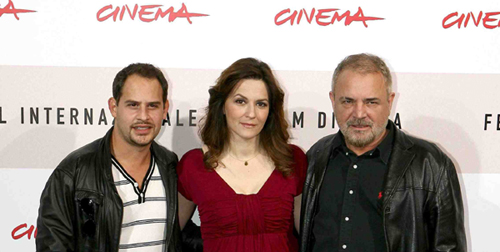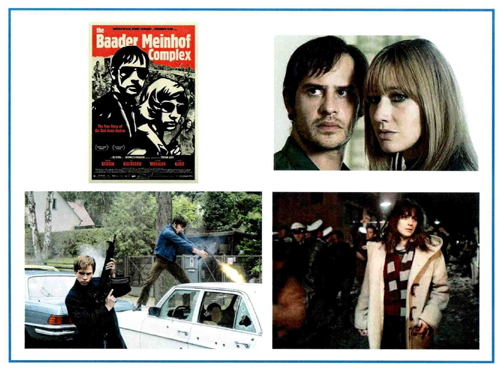THE BAADER-MEINHOF COMPLEX:
The Rise of German Rebels
Special to FILMS FOR TWO®
By Jill Jaracz

From Left: Moritz Bleibtreu (“Andreas Baader”) and Martina Gedeck (“Ulrike Meinhof”) with director Uli Edel
at the Rome International Film Festival (October 24, 2008). Photo Credit: Sipa
Photos/NewsCom.
THE BAADER-MEINHOF
COMPLEX, a German film that received both Golden Globe and Oscar nominations this year, tells the story of a harrowing part of Germany’s recent history: the reign of terror created by the R.A.F. (Red Army Faction), also known as the Baader-Meinhof Gang.
This movie, based on the book Baader-Meinhof: The Inside Story of the R.A.F. by Stefan Aust, focuses mostly on the beginning of this faction and its original leaders. It starts in 1967, a period of time when the fashionable thing to do in Germany was to protest. Students and other youth led protests throughout the country, crying out against anything they could think of. Many of these revolved around America’s invasion of Vietnam, because the students feared American’s imperialistic impulses would turn America into another Nazi Germany that pushed to take over the world.
In June 1967, thousands of students gathered in front of the Berlin Opera House to protest the repressive leadership of the Shah of Iran, who was visiting the city. The protesters lined up between a long line of barricades and buildings, and the police decided to break up the protest by rushing the middle of the pack. Protestors panicked and fled sideways, where more police were waiting to surprise them. During this entire scuffle, the police killed a student, who became a martyr for the growing protest movement.
As the film shows, Berlin puts a ban on protests following this incident, but that doesn’t stop the movement. Later that summer, Andreas Baader (played by Moritz Bleibtreu of
MUNICH and RUN LOLA
RUN) meets Gudrun Ensslin (played by Johanna Wokalek), and they begin to form their own protest gang. They initially target capitalism by setting off bombs in department stores, but they usually wait until the stores are closed because they don’t want to hurt innocent people. Over the next couple of years the group carries out similar attacks, and soon Baader, Ensslin, and other gang members are caught and imprisoned for arson.
They soon recruit popular leftist journalist Ulrike Meinhof (played by Martina Gedeck of
MOSTLY MARTHA and THE LIVES OF
OTHERS), who decides that actions speak louder than words, and that her columns aren’t going to change the world in the way that she wants. She quits her job and leaves her children behind to follow her beliefs.
In 1970, Baader is in prison, so Meinhof creates a plan to help him escape. She gets a publisher, who is unaware that Baader and Meinhof are acquainted, to hire the two of them to write a book together. She and Baader meet at a research library, supposedly to work, but it’s all a ruse. Other members of the gang show up at the library and occupy the security guards, allowing Baader and Meinhof to flee through a window. After this, the press starts referring to them as the Baader-Meinhof Gang.

Film stills © Vitagraph Films. All Rights Reserved.
Director Uli Edel rises to the challenge of bringing this complicated and involved story to the screen, all while commanding superb performances from his actors. Bleibtreu’s portrayal of Baader is rebellious, yet pragmatic. He has a charisma that shines through to attract followers, and although he acts out against the establishment, he shows great control in what he does and does not want his gang to do. Johanna Wokalek’s Ensslin is a sultry mix of sensuality and rage against the government. Her boldness and willingness to speak out helps their supporters stay riled up against their foes. Her character almost overshadows Meinhof, a nicely subtle portrayal by Gedeck, who brings Meinhof’s shyness through. It’s much easier for Meinhof to speak through her writing, and Gedeck really uses body language well to help the character express herself.
The movie’s 150-minute running time is daunting, but it never lags. Let’s face it though: Fitting ten years of terrorism into a movie can be difficult, so without knowing more of the history, some of the more interesting details of the film—including a reference to an ingenious communications system the first generation members created in prison—can elude you. At times the R.A.F.’s criminal activities are non-stop, and it’s sometimes difficult to piece them all together and understand the bigger picture, especially as Edel chooses to end the film somewhat abruptly and doesn’t go into the latter years of the R.A.F. Given the level of detail and already long running time of the film, it just isn’t possible to tell the full story of this group.
Still, Edel does an incredible job of recreating post-World War II Germany and committing this era to the screen. He doesn’t side with the terrorists or glorify their actions. He also takes great pains to show the government’s side of the story in their quest to understand this new breed of terrorism and track down and bring justice to these criminals.
Interestingly, the Baader-Meinhof Gang era spurned other German movies about terrorist groups that have a decidedly more Hollywood spin. 2002’s
WHAT TO DO IN CASE OF FIRE and 2004’s THE
EDUKATORS both deal with anarchist groups, but the fate of the terrorist groups in these movies is slightly more positive, and therefore, less realistic. Although the comedic edge—and the references to the R.A.F. in these movies—make for entertaining films, the realism of THE
BAADER-MEINHOF COMPLEX and the care taken to recreate this era of history makes for a more powerful movie-going experience.
© Jill Jaracz (9/1/09)
Special for FILMS FOR TWO®
************
